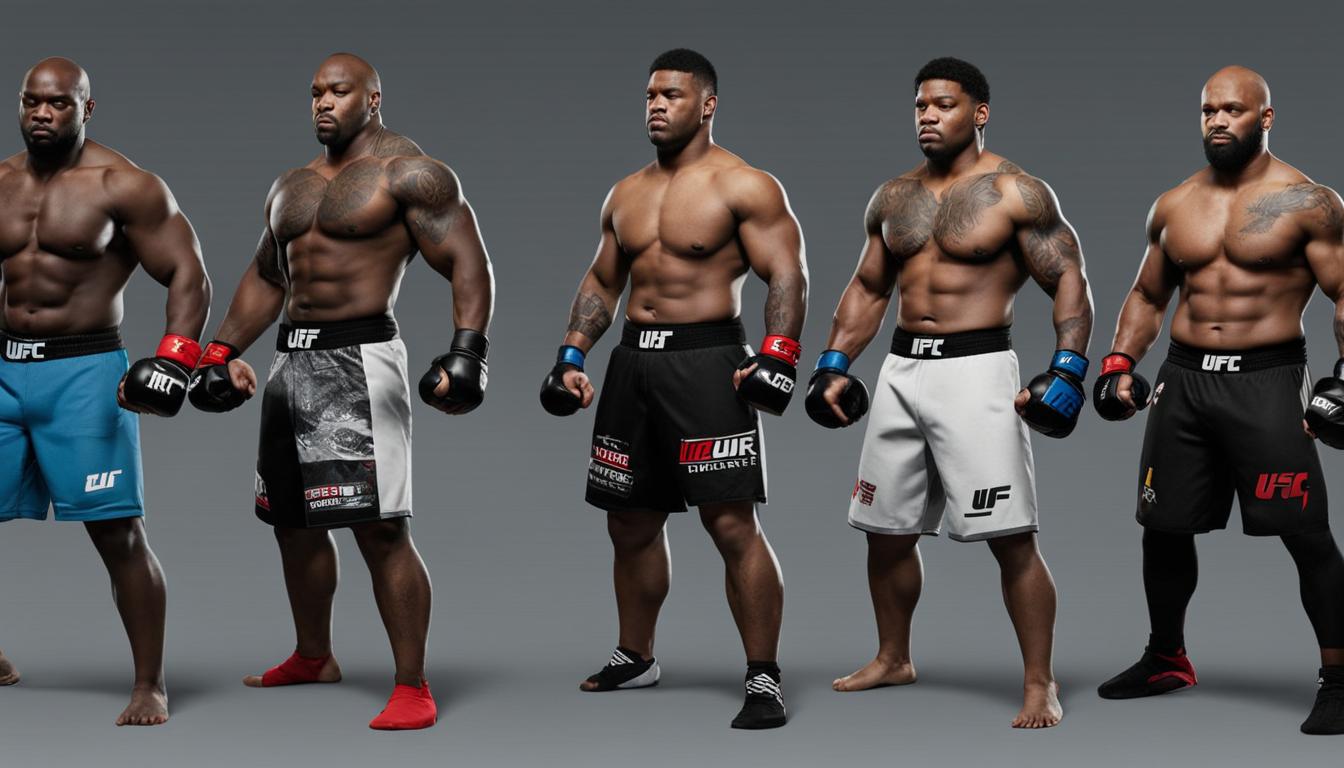Hey there, fight fans! Are you ready to dive into the exciting world of UFC weight classes? Strap in, because I’m here to guide you through the ins and outs of these divisions, so you can understand them like a pro.
In the thrilling world of mixed martial arts, fighters are divided into different weight classes to ensure fair competition. Each weight class has its own set of rules and regulations, including specific weight limits that fighters must adhere to. By competing in their respective weight classes, athletes can showcase their skills against opponents of similar size and weight.
Key Takeaways:
- UFC weight classes are essential for fair competition and safety.
- Each weight class has a specific weight limit that fighters must meet.
- Failure to make weight can result in penalties or the cancellation of a fight.
- Weigh-ins take place the day before the fight, and fighters have additional time to make weight if they miss it initially.
- Non-title bouts allow a one-pound allowance above the division’s limit.
Strawweight – 115 pounds
The strawweight division in the UFC is exclusively for women and has a weight limit of 115 pounds. This weight class is known for its fast-paced and technical fights, showcasing the skill and agility of its fighters. The strawweight division had some exciting moments in 2023 as new champions emerged.
Alexa Grasso made history in March when she captured the women’s strawweight belt, showcasing her striking prowess and ability to control the octagon. Her victory marked a significant milestone in her career and solidified her position as one of the top fighters in the division.
Alexa Grasso’s winning the women’s belt in March was a testament to her unwavering determination and skill in the strawweight division.
Just a few months later, Alexandre Pantoja became the men’s strawweight champion, displaying his well-rounded abilities and dominance in the division. His victory showcased his versatility in both striking and grappling, making him a formidable force to reckon with.
In the strawweight division, athletes are required to weigh in at or under 115 pounds for title fights, ensuring fairness and equal competition. For non-title bouts, a one-pound weight allowance is granted, providing some flexibility for fighters.
The strawweight division continues to captivate fans and deliver exhilarating fights, with its fighters showcasing their skills and determination inside the octagon.
Key Points:
- Strawweight division in UFC is exclusively for women.
- Weight limit for strawweight division is 115 pounds.
- Alexa Grasso won the women’s strawweight belt in March.
- Alexandre Pantoja became the men’s strawweight champion in July.
- Title fights require athletes to weigh in at or under 115 pounds.
- For non-title bouts, a one-pound allowance is granted.
Bantamweight – 135 pounds
The bantamweight division in the UFC is an exciting weight class that features both male and female fighters. With a weight limit of 135 pounds, this division showcases the speed, skill, and agility of its competitors. Notable fighters such as Amanda Nunes and Ronda Rousey have made their mark in the bantamweight division, dazzling fans with their impressive performances.
When it comes to competing in the bantamweight division, athletes must meet the weight limit of 135 pounds for both title fights and non-title bouts. Weigh-ins are a crucial aspect of the fight process, ensuring that fighters adhere to the weight limit and maintain a fair and level playing field.
As with all weight classes in the UFC, fighters aim to weigh in at or under the specific weight to avoid penalties and ensure a competitive advantage. Empowering fighters to compete at their optimal weight, the 135-pound weight class adds excitement and intensity to the octagon. Whether it’s the explosive striking or the submission grappling, the bantamweight division showcases the incredible talent and athleticism of its fighters.
Lightweight – 155 pounds
The lightweight division in the UFC is known for its depth of talent and the exciting fights it produces. With a weight limit of 155 pounds, this division showcases some of the most skilled and agile fighters in the sport. Former champion Khabib Nurmagomedov, with his dominant grappling and relentless pressure, was a force to be reckoned with in the lightweight division before his retirement.
Athletes competing in the lightweight division must weigh in at or under 155 pounds for both title fights and non-title bouts. This weight class provides a perfect balance between power and speed, allowing fighters to showcase their technical abilities while maintaining a level of athleticism.
Some of the most notable fighters in the lightweight division include Conor McGregor, Dustin Poirier, and Tony Ferguson. These athletes have captured the attention of fans worldwide with their incredible performances and highlight-reel knockouts.
The lightweight division has always been highly competitive, with fighters constantly pushing the limits of their skills to secure victory. The weight limit of 155 pounds ensures that the fighters are evenly matched in terms of size and power, leading to thrilling battles inside the octagon.
The Rise of the Lightweight Division
Over the years, the lightweight division has seen an influx of talent and a rise in popularity. The emergence of fighters like Nate Diaz and Justin Gaethje has brought even more excitement to the division, with their relentless fighting styles and never-back-down attitudes.
The lightweight division is stacked with talented fighters who are hungry for success. The competition at 155 pounds is fierce, and every fighter knows that a single mistake can cost them the victory.
With its weight limit of 155 pounds, the lightweight division provides a platform for fighters to showcase their skills and make a name for themselves in the UFC. Fans can expect explosive striking, crafty submissions, and non-stop action in every lightweight matchup.
As the lightweight division continues to evolve, we can anticipate new stars to rise to the top and create unforgettable moments in the octagon. Whether it’s a technical chess match or an all-out war, the fighters in the lightweight division never fail to entertain and amaze.
Welterweight – 170 pounds
The welterweight division in the UFC is one of the most exciting weight classes, with a weight limit of 170 pounds. It is known for its highly skilled and powerful fighters who compete in this 170-pound weight class.
Recent contenders in the welterweight division have showcased incredible talent and strength. Athletes such as Leon Edwards and Khamzat Chimaev have made waves in the UFC welterweight division, proving their prowess inside the octagon.
Athletes competing in the welterweight division must weigh in at or under 170 pounds for both title fights and non-title bouts. This weight limit ensures fair competition and maintains the division’s integrity.
Competing in the welterweight division requires discipline and training to achieve and maintain the optimal weight for performance. Fighters must carefully manage their nutrition and training regimens to reach and maintain the 170-pound weight limit.
As we can see in the image above, the welterweight division brings together elite fighters who possess the size, skill, and power to compete at the 170-pound weight class. They showcase their talents to fight for titles and climb the welterweight rankings.
| Notable Welterweight UFC Fighters | Weight (pounds) |
|---|---|
| Leon Edwards | 170 |
| Khamzat Chimaev | 170 |
| Stephen Thompson | 170 |
| Kamaru Usman | 170 |
The table above highlights some notable welterweight UFC fighters and their respective weights. These athletes exemplify the strength and skills required to compete in the welterweight division.
Middleweight – 185 pounds
The middleweight division in the UFC is a highly competitive weight class with a weight limit of 185 pounds. This division features some of the most skilled fighters in the organization who possess a unique combination of speed, power, and technique.
Athletes in the middleweight division often weigh in several pounds under the required limit, as they strive to optimize their performance and maintain a competitive advantage. This weight class offers a good balance between size and agility, allowing fighters to showcase their skills without sacrificing speed or endurance.
When competing in the middleweight division, athletes must weigh in at or under 185 pounds for both title fights and non-title bouts. This weight limit ensures a level playing field and a fair competition among fighters of similar size and strength.
As the middleweight division continues to evolve, fighters like Israel Adesanya and Robert Whittaker have established themselves as dominant forces in the weight class. These athletes have displayed exceptional striking ability, technical prowess, and an innate understanding of the middleweight division’s dynamics.
| Notable Middleweight Fighters | Record |
|---|---|
| Israel Adesanya | 20-1-0 |
| Robert Whittaker | 24-5-0 |
| Paulo Costa | 13-1-0 |
| Darren Till | 18-3-1 |
The middleweight division showcases a mix of striking, grappling, and well-rounded skills, making it one of the most exciting weight classes in the UFC. Fans can expect thrilling matchups and high-level competition whenever the middleweight fighters step into the octagon.
Conclusion
Understanding UFC weight classes is essential for fighters and fans alike. With 12 weight classes and specific weight limits for each division, fighters must aim to make weight to compete in their respective categories. Failure to make weight can result in penalties or even fight cancellation.
By knowing the weight limits of each division and following the rules, fighters can choose the right UFC weight class for themselves. This allows them to compete at their optimal weight and maximize their performance in the octagon. It is crucial for fighters to strike a balance between their natural weight, their ability to make weight, and their performance in the cage.
For fans, understanding UFC weight divisions is important in order to appreciate the skill and talent displayed by fighters in their respective weight classes. Each division has its own unique characteristics and roster of athletes, creating a variety of exciting matchups and rivalries.



